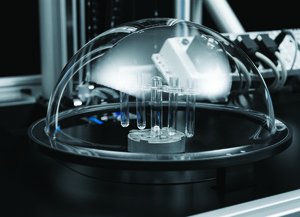
 |
Charlotte Stonestreet
Managing Editor |
Editor's Pick
Superconductors & their potential for industrial automation
20 January 2015
For the industrial automation sector, superconductor technology is still in the development/demonstration stage. Their special properties show early promise for solving specific industrial automation issues and opening up completely new application fields of the future, asserts Festo

"Superconductivity is a fascinating topic of today’s physics and technology research,” says Steve Sands, product manager at Festo. "Once a superconductor reaches its transition temperature, it stores the magnetic field – and hence the defined distance parallel to the magnet – and its electrical resistance also suddenly drops to zero. If voltage is applied, the superconductor conducts the electrical current without resistance. If the current in the superconducting material is put into motion, it flows without any losses in a closed circuit. Magnetic fields generated in this way can be used with very good energy efficiency.”
For several years, Festo has been carrying out research with partners from science and industry into the application of superconductor technology within automation. The first research platforms presented a year ago demonstrated how objects can be maintained in a state of levitation and be moved without contact. Under the heading Supramotion, this phenomena was shown in three separate displays – SupraHandling, SupraShuttle and SupraChanger. These examples have been further developed to explore contactless transport and handling of ‘hovering’ objects in all orientations and even within totally enclosed spaces.
Early experiments used liquid nitrogen to chill the superconductor materials making them expensive, bulky and difficult to transport and set up. Supramotion 2.0 makes use of electric cooling or cryostats. Whilst electrical resistance drops in standard materials at extremely low temperatures nearing absolute zero, Festo is using so called ‘high-temperature’ superconductors with a transition temperature of ‘only’ 93 Kelvin (-180°C), which is far more energy efficient and practicable for industrial applications.
The first Supramotion 2.0 display is called SupraHandling 2.0; it is a levitating carriage, fitted with three cryostats, that moves over two magnetic rails 2.5 metres in length. The entire system can be rotated by up to 180 degrees about its longitudinal axis, thus enabling the carriage to travel vertically or even upside-down.
"SupraHandling 2.0 thus demonstrates stable non-contact positioning, which for example could enable the levitated transportation of objects in production,” explains Sands. "Besides movement in all spatial planes, the SupraHandling 2.0 demonstrates how to transport objects without friction loss. Amazingly, the cooling system for the three superconductors requires only 80W per unit to drop the temperature down and just 12W per cryostat to maintain the critical temperature.”
The SupraShuttle 2.0 demonstrates movement of a levitating object in all directions and, for the first time, the handling of the superconductor element itself: the cryostat with the superconducting material is transferred from one electric axis system to another.
"The SupraShuttle 2.0 exhibit also shows how hovering objects can be introduced into a hermetically sealed space and moved within it,” explains Sands. "This feature would be useful, for example, for applications involving work with gases, in a vacuum or anywhere a high degree of isolation is required such as processing chambers.”
Exploring the possibilities for tool changing in environments such as laboratory automation, SupraChanger 2.0 features a rotating baseplate.
"This exhibit has three stations where different rotary functions are conducted: a centrifuge, a mixer and a rotary indexing table,” says Sands. "In this way several processing steps could be performed on a sample in sequence.”
Each station has a magnetic disc and as it comes into position over the superconductor module the disc reacts and begins to hover. A stepper motor under the baseplate sets the magnetic disc in the station, and thus the respective application, rotating in their specific manner. Therefore a single drive is used for each of the stations basically acting as a tool changer with a contactless drive mechanism.
Superconductors are showing the potential to move objects beyond walls, in confined spaces and in all orientations. They show great application potential wherever isolation is required for extreme temperatures or to prevent contamination of samples or operators. Energy efficiency is also an important aspect where eliminating frictional losses, which could enable the use of smaller, more efficient drives.
- PPS becomes Festo Official Partner
- New standard in precision positioning
- Industry 4.0: Revolution or evolution?
- Air Flow & Pressure Switching Point Adjustment
- Engineering the path to sustainability
- Full Servo Motion Advantages At A Fraction Of The Cost
- Entering the next stage with artificial intelligence
- Packaging system concepts
- Lightweight & compact air preparation unit
- Servo drive developer kit
- No related articles listed




















